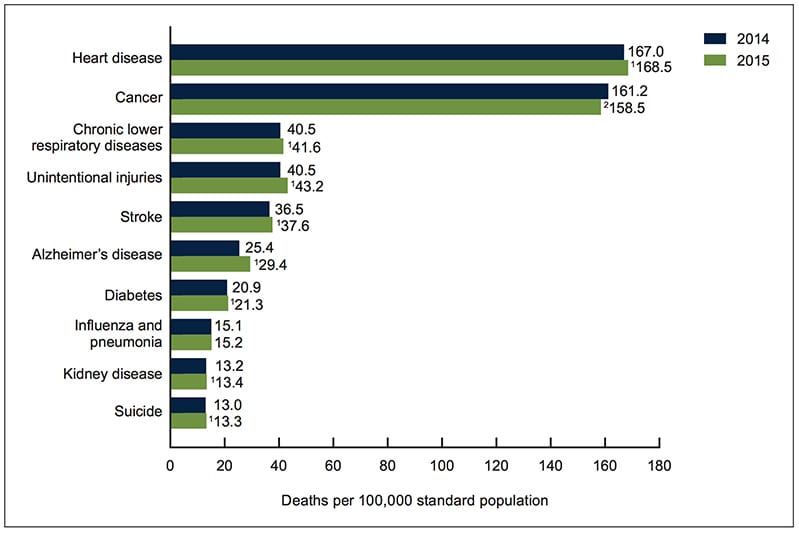United States life expectancy declines for first time since the ’90s, partly due to alcohol and other drugs
For the first time in more than 20 years, life expectancy for citizens of the USA declined in 2015 — a troubling development linked in large part to alcohol and other drugs.
Overall, life expectancy fell by one-tenth of a year, from 78.9 in 2014 to 78.8 in 2015, according to the latest data. The last time U.S. life expectancy at birth declined was in 1993, when it dropped from 75.6 to 75.4, according to World Bank data.
The overall death rate rose 1.2% in 2015, its first uptick since 1999. More than 2.7 million people died, about 45% of them from heart disease or cancer.
Causes for decline in life expectancies
Increasing numbers of deaths from heart disease and stroke, diabetes, alcohol-related deaths, narcotic drug overdoses, accidents and other conditions caused the life expectancy decline revealed in a report by the National Center for Health Statistics at the CDC (Centers for Disease Control and Prevention). In summary, the report (PDF) shows that death rates rose for eight of the top ten leading causes of death in the United States.
Age-adjusted death rates for the 10 leading causes of death in 2015: The United States, 2014 and 2015

1Statistically significant increase in age-adjusted death rate from 2014 to 2015 (p < 0.05). 2Statistically significant decrease in age-adjusted death rate from 2014 to 2015 (p < 0.05). NOTES: A total of 2,712,630 resident deaths were registered in the United States in 2015. The 10 leading causes accounted for 74.2% of all deaths in the United States in 2015. Causes of death are ranked according to the number of deaths. Access data table for Figure 3 at: http://www.cdc.gov/nchs/data/databriefs/ db267_table.pdf#3. SOURCE: NCHS, National Vital Statistics System, Mortality.
Heart disease was responsible for more than 633,000 deaths in 2015, up from a little more than 614,000 the previous year. Cancer killed more than 595,000 people.
We’re seeing the ramifications of the increase in obesity,” Tom Frieden, director of the CDC, said to The Washington Post.
And we’re seeing that in an increase in heart disease.”
The number of unintentional injuries — which include overdoses from drugs, alcohol, and other chemicals, as well as motor vehicle crashes and other accidents — climbed to more than 146,000 in 2015 from slightly more than 136,000 in 2014.
Deaths from suicide, the 10th-leading cause of death in the United States, rose to 44,193 from 42,773 in 2014.
Diseases of despair
Heart disease, cancer, unintentional injuries, suicide – they all have something in common: alcohol is a direct cause and risk factor. In fact, out of the top ten causes of deaths in the United States, at least seven are alcohol-related; meaning that alcohol is a risk factor and direct cause.
Already in 2015, an unexpected jump in US mortality rates among white middle-aged Americans received attention around the globe. This trend is continuing. And scientists coined it “diseases of despair” in order to highlight the cause of the trend:
- Overdoses,
- Alcoholism, and
- Suicide.
Alcohol harm, silent epidemic in the US
What the new figures show, is that major illnesses and risk factors may be eroding life expectancies for an even wider group of people in the US.
More than 33,000 people in the US died due to alcohol-induced causes in 2015. The problem is that this epidemic of alcohol deaths receives considerably less attention.
Taking into account all other kinds of alcohol-related fatalities that are not present in this data set, such as driving under the influence and homicides, the total number of alcohol-related deaths per year rises considerably: 88,000 alcohol-related deaths a year in the US.
Decline in life expectancies is political choice
At least as far as alcohol policy making is concerned, the increase rate of mortality in the United States is of political making. Elected officials are not putting place that would help prevent and reduce the number of alcohol-related deaths. Some of the measures are listed in a VOX.COM article, by German Lopez:
- Increasing the alcohol tax
The alcohol tax has not been increased since the 1990s in the US. As a matter of fact, that means that alcohol has become cheaper. A 2010 review of the research in the American Journal of Public Health revealed strong evidence:Our results suggest that doubling the alcohol tax would reduce alcohol-related mortality by an average of 35%, traffic crash deaths by 11%, sexually transmitted disease by 6%, violence by 2%, and crime by 1.4%.”
- Reducing the number of alcohol outlets
A 2009 review published in the American Journal of Preventive Medicine found that limiting the number of alcohol outlets can reduce alcohol harm. - Put state governments in charge of selling alcohol
A 2014 RAND report concluded that when state governments monopolize alcohol retail, they can keep prices higher, reduce access to youth, and reduce overall levels of use and associated harm.
